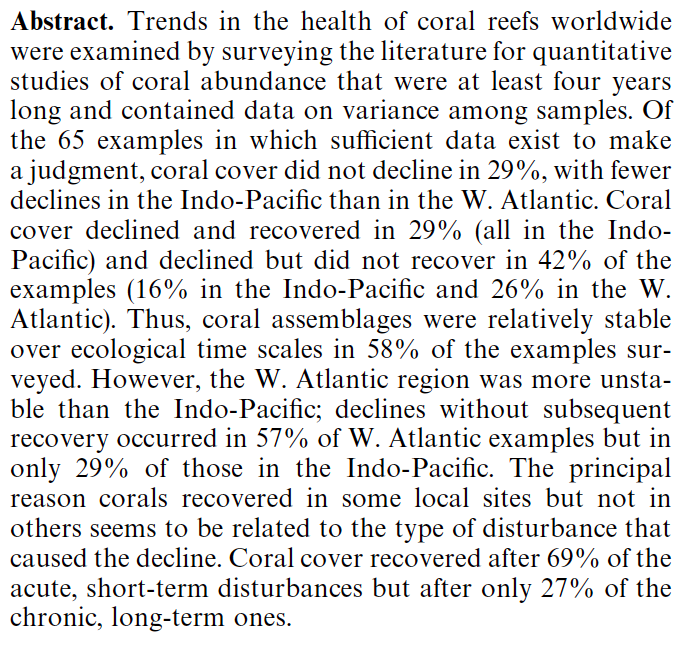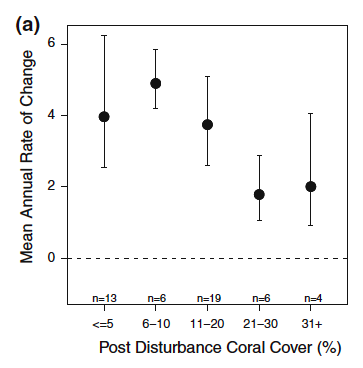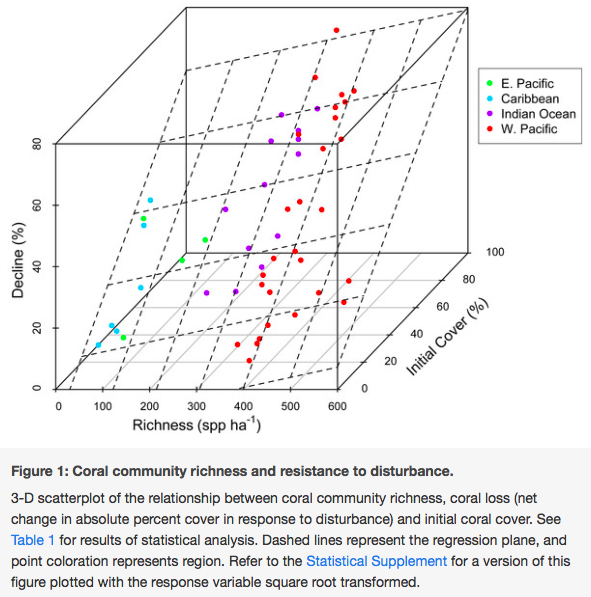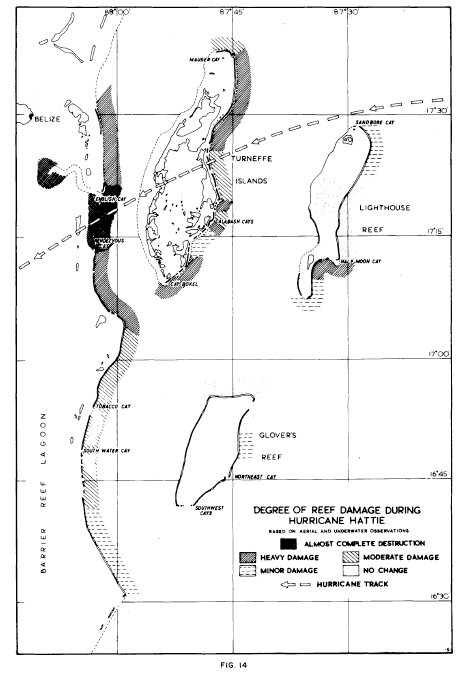 Coral reefs are affected by a large range of disturbances including disease, bleaching, storms, and Acanthaster planci, also known as crown of thorn starfish (COTS) outbreaks. There appears to be a lot of variation of how much coral cover is affected by physical and biological disturbances and in how quickly coral communities recover from it. Those two ecological processes, resistance to and recovery from disturbance, make up “resilience” (although in some corners of coral reef science, the recovery component is emphasized and nearly synonymous with resilience). Resistance and recovery (and the disturbance regime they are linked to) control ecological “stability” or the degree to which population or community state varies with time.
Coral reefs are affected by a large range of disturbances including disease, bleaching, storms, and Acanthaster planci, also known as crown of thorn starfish (COTS) outbreaks. There appears to be a lot of variation of how much coral cover is affected by physical and biological disturbances and in how quickly coral communities recover from it. Those two ecological processes, resistance to and recovery from disturbance, make up “resilience” (although in some corners of coral reef science, the recovery component is emphasized and nearly synonymous with resilience). Resistance and recovery (and the disturbance regime they are linked to) control ecological “stability” or the degree to which population or community state varies with time.
People have been quantifying coral community resilience in the field for many decades. Stoddart (1974) studied the effects of hurricane hattie on the near-pristine reefs of Belize in 1961 (when it was still part of the British Empire and called “British Honduras”) and Endean and Stablum (1973) documented the effects of the first of many COTS outbreaks on the Great Barrier Reef.
And of course Joe Connell studied the waxing and waning of shallow water coral cover (and species richness) in response to disturbance on Heron Island, GBR for decades (and probably still is). Connell (1997) was also the first person I know of to synthesize this literature, although exhaustive, he employed pre-meta-analysis “vote counting” and his effort wasn’t exactly quantitatively sophisticated:
 Graham et al. 2011 sort of picked up where Connell left off with a meta-analysis of the recovery of coral communities around the world. Surprisingly, they found that disturbance type, e.g., “physical” vs. “biological” disturbances, and other reef characteristics including connectivity had little effect on recovery rate. Region did seem to affect recovery, with it being fastest in the western Pacific, i.e., the most diverse place:
Graham et al. 2011 sort of picked up where Connell left off with a meta-analysis of the recovery of coral communities around the world. Surprisingly, they found that disturbance type, e.g., “physical” vs. “biological” disturbances, and other reef characteristics including connectivity had little effect on recovery rate. Region did seem to affect recovery, with it being fastest in the western Pacific, i.e., the most diverse place: Human population density and management status also appeared to effect recovery rates, but not in ways that you would have expected!
Human population density and management status also appeared to effect recovery rates, but not in ways that you would have expected!
Reefs with lower post-disturbance coral cover tended to recover more quickly:
 I recently taught an undergraduate seminar class in which for a class project, we expanded on the Graham et al study and asked: Is coral species richness related to resistance to and recovery from disturbances?
I recently taught an undergraduate seminar class in which for a class project, we expanded on the Graham et al study and asked: Is coral species richness related to resistance to and recovery from disturbances?
More diverse communities are thought to be more stable—the diversity–stability hypothesis—due to increased resistance to and recovery from disturbances. For example, high diversity can make the presence of resilient or fast growing species and key facilitations among species more likely. How natural, geographic biodiversity patterns and changes in biodiversity due to human activities mediate community-level disturbance dynamics is largely unknown, especially in diverse systems. For example, few studies have explored the role of diversity in tropical marine communities, especially at large scales.
We contacted Dr. Nick Graham, he shared his database with us (thanks Nick!)(which you can download here). We synthesized the results of 41 field studies conducted on 82 reefs, documenting changes in coral cover due to disturbance, across a global gradient of coral richness. The students added the resistance / coral loss data (the original study just looked at recovery) and we used Veron’s coral richness maps to estimate local richness (at the sites of the disturbance studies).
Our results (Zhang et al. 2014) indicate that coral reefs in more species-rich regions were marginally less resistant to disturbance and did not recover more quickly.
 Coral community resistance was also highly dependent on pre-disturbance coral cover, probably due in part to the sensitivity of fast-growing and often dominant plating acroporid corals to disturbance. Our results suggest that coral communities in biodiverse regions, such as the western Pacific, may not be more resistant and resilient to natural and anthropogenic disturbances. Further analyses controlling for disturbance intensity and other drivers of coral loss and recovery could improve our understanding of the influence of diversity on community stability in coral reef ecosystems. Read more here at PeerJ: Zhang et al. 2014.
Coral community resistance was also highly dependent on pre-disturbance coral cover, probably due in part to the sensitivity of fast-growing and often dominant plating acroporid corals to disturbance. Our results suggest that coral communities in biodiverse regions, such as the western Pacific, may not be more resistant and resilient to natural and anthropogenic disturbances. Further analyses controlling for disturbance intensity and other drivers of coral loss and recovery could improve our understanding of the influence of diversity on community stability in coral reef ecosystems. Read more here at PeerJ: Zhang et al. 2014.
Literature Cited
Connell, J.H. (1997). Disturbance and recovery of coral assemblages. Coral Reefs, 16, S101–S113.
Endean, R. & Stablum, W. (1973). The apparent extent of recovery of reefs of Australia’s Great Barrier Reef devastated by the crown-of-thorns starfish. Atoll Research Bulletin, 168, 1–41.
Stoddart, D.R., 1974. Post-hurricane changes on the British Honduras reefs: resurvey of 1972. In: Proceedings of the Second International Coral Reef Symposium, vol. 2, pp. 473–483


Leave a Reply